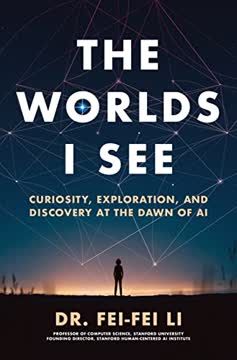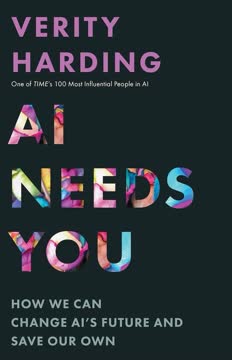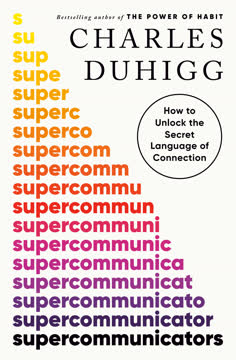Key Takeaways
1. The expert-novice bond is crucial for skill development
Welcome to the expert-novice bond—a relationship that predates most of what we consider to be civilization.
Ancient origins. The expert-novice bond has been the bedrock of human skill transfer for at least 160,000 years. This relationship, exemplified by apprenticeships, has been crucial in passing down skills and knowledge across generations. From ancient sculptors to modern surgeons, the pattern remains consistent: novices learn by working alongside experts, gradually taking on more complex tasks under guidance.
Universal application. This learning method transcends industries and cultures. Whether in carpentry, midwifery, or high-energy physics, the process of seeing, doing, and teaching forms the core of skill acquisition. Even in the age of formal education and online learning, this bond remains essential for developing practical, real-world skills that can be reliably applied under pressure.
2. Challenge, complexity, and connection form the skill code
Like the four amino acids are to genetics, the three Cs are the basic building blocks of how we learn our most valuable skills.
Challenge. Healthy challenge involves tasks that push learners to their limits without overwhelming them. It requires a balance where novices can perform tasks well, but not at their best, allowing for minor failures and recovery. This optimal challenge point varies for each individual and task, making personalized guidance crucial.
Complexity. Engaging with complexity means understanding the broader context of tasks. It involves minimal upfront explicit learning, focusing instead on implicit learning through experience. Experts play a key role by directing attention to complex aspects without over-interpreting, allowing novices to form their own understanding.
Connection. Healthy connection is built on trust, respect, and care between experts and novices. It involves attunement to each other, feedback on the relationship, and joint adjustment of goals. This connection not only facilitates skill transfer but also provides motivation and meaning in work.
3. Technology threatens traditional skill-building methods
We are cutting workers who need to learn out of the loop in the name of increased expert productivity.
Productivity vs. skill. New technologies, while increasing productivity, often separate experts from novices. This separation disrupts the traditional expert-novice bond, limiting opportunities for novices to learn through observation and guided practice. For example, robotic surgery allows expert surgeons to operate independently, reducing residents' learning opportunities.
Widespread impact. This trend is not limited to high-tech fields. Across industries, from investment banking to warehousing, technology is reshaping work processes in ways that often isolate novices from complex tasks and expert guidance. The result is a growing skills gap, where workers struggle to develop the comprehensive skills needed for career advancement and adaptability.
Fields affected include:
- Healthcare
- Finance
- Manufacturing
- Law
- Education
- Technology
4. Shadow learning emerges as a response to skill barriers
Shadow learners have intuitively worked out the skill code and found a way to rework it so they can keep building skill in spite of new barriers.
Unconventional methods. Shadow learning involves finding creative, often rule-bending ways to gain skills when traditional paths are blocked. Examples include medical residents extensively studying surgical videos, warehouse workers experimenting with equipment off-hours, or junior bankers reverse-engineering complex financial models.
Risk and reward. While shadow learning can lead to impressive skill development, it often comes with risks. Practitioners may face professional consequences or even ethical dilemmas. However, these methods also provide valuable insights into how skill development can adapt to changing technological landscapes.
Common shadow learning tactics:
- Premature specialization
- Digital rehearsal
- Undersupervised struggle
- Inverted apprenticeships
5. Discover, develop, and deploy to rework the skill code
We need to draw on the skill code to develop a system of durable organizational structures like policies, norms, rules, processes, and roles that will help anyone build skill as they do their job.
Discover. Organizations must invest in understanding how the skill code manifests in their specific context. This involves identifying threats to healthy challenge, complexity, and connection, as well as uncovering existing shadow learning practices.
Develop. Based on these discoveries, new rules and structures should be developed to foster skill-building. This might include realigning roles to reconnect experts and novices, reworking performance metrics to reward skill development, and tapping into frontline know-how.
Deploy. Implementation is crucial. This involves actively using new technologies in ways that enhance rather than hinder skill development. It requires a commitment from all levels of an organization to prioritize skill alongside productivity.
Key deployment strategies:
- Insist on solutions that achieve both productivity and skill development
- Engage technology vendors in skill-centric feature development
- Cultivate a culture that values and rewards skill-building efforts
6. A chimeric future blends human and AI capabilities
To save human ability in an age of intelligent machines, we've got to build one. Starting right now.
Digital apprenticeship. The future of skill development lies in creating a "digital apprenticeship" infrastructure. This involves using AI, robotics, and other advanced technologies to enhance rather than replace the expert-novice bond. Platforms like SkillNet, described in the book, could provide personalized, AI-assisted learning experiences that preserve human connection.
Augmented learning. In this vision, AI systems work alongside humans to provide tailored challenges, expose learners to appropriate complexity, and facilitate connections between experts and novices globally. This approach could democratize access to high-quality skill development opportunities across industries and geographies.
Potential features of a digital apprenticeship system:
- AI-driven matching of experts and novices
- Virtual reality training environments
- Real-time feedback and guidance during task performance
- Global knowledge sharing and collaboration platforms
7. Everyone has a role in preserving and enhancing skill
However much or little power you feel you have, you have a critical role in ushering in this future.
Individual responsibility. Whether you're a novice, expert, manager, entrepreneur, or policymaker, you have a part to play in fostering healthy skill development. This involves actively seeking or creating opportunities for challenge, complexity, and connection in your work and learning environments.
Collective action. Addressing the threat to skill development requires a coordinated effort across society. Organizations need to prioritize skill alongside productivity, technology developers must consider skill-building in their designs, and policymakers should invest in infrastructure that supports lifelong learning.
Actions for different roles:
- Novices: Seek out challenging assignments and mentorship opportunities
- Experts: Actively engage in teaching and mentoring, even when it's not formally required
- Managers: Design work processes that facilitate expert-novice interaction
- Entrepreneurs: Develop technologies that enhance rather than replace human skill
- Policymakers: Invest in research and infrastructure for skill development
Last updated:
FAQ
What's The Skill Code about?
- Focus on Skill Development: The Skill Code by Matt Beane examines how human skills are cultivated and transferred, especially in the era of intelligent machines.
- Three Key Components: The book highlights challenge, complexity, and connection as essential elements for effective skill development.
- Impact of Technology: It discusses how modern technologies can disrupt traditional skill acquisition pathways by isolating novices from experts.
Why should I read The Skill Code?
- Understanding Modern Work: The book provides insights into the changing dynamics of work due to intelligent technologies.
- Practical Framework: Beane offers a framework for enhancing skill development applicable across various industries.
- Awareness of Challenges: It raises awareness about the potential pitfalls of technology in the workplace and encourages critical engagement with new tools.
What are the key takeaways of The Skill Code?
- Expert-Novice Bond: The relationship between experts and novices is crucial for skill development and knowledge transfer.
- Three Cs of Skill Development: Challenge, complexity, and connection are vital for creating a conducive learning environment.
- Technological Threats: Intelligent technologies can disrupt traditional skill acquisition by separating novices from experts.
What is the expert-novice bond, and why is it important in The Skill Code?
- Foundation of Learning: This bond is a collaborative relationship where novices learn from experts through observation and practice.
- Mutual Benefit: Experts gain assistance, while novices acquire valuable skills and insights.
- Historical Context: Beane uses historical examples to illustrate the enduring significance of this relationship.
How does The Skill Code define the three Cs: challenge, complexity, and connection?
- Challenge: Involves engaging with tasks that push learners beyond their current capabilities, fostering growth.
- Complexity: Refers to understanding the broader context of tasks, enhancing problem-solving abilities.
- Connection: Emphasizes building trust and respect between experts and novices, facilitating effective learning.
How does technology threaten skill development according to The Skill Code?
- Isolation of Novices: Intelligent technologies can create barriers between novices and experts, reducing hands-on learning opportunities.
- Focus on Efficiency: Organizations may prioritize productivity over skill development, leading to a decline in training quality.
- Loss of Informal Learning: Technology can diminish spontaneous interactions crucial for relationship building and knowledge sharing.
What is shadow learning in The Skill Code?
- Definition of Shadow Learning: Refers to informal ways individuals develop skills outside traditional training methods.
- Examples of Shadow Learners: Individuals like Inés and Gerardo enhance their skills despite organizational barriers.
- Importance for Skill Development: Shadow learning allows individuals to adapt and thrive in rapidly changing environments.
What are the best quotes from The Skill Code and what do they mean?
- Adapting Work Practices: “If we want a world where working hard today offers a more skillful tomorrow, we need to do better.”
- Restoring Essential Elements: “Healthy challenge, complexity, and connection are on the ropes, and it’s all our own doing.”
- Resilience of Shadow Learners: “Shadow learners have intuitively worked out the skill code and found a way to rework it so they can keep building skill in spite of new barriers.”
How can organizations foster healthy challenge, complexity, and connection according to The Skill Code?
- Encourage Collaboration: Promote teamwork and mentorship between experts and novices through structured programs.
- Design for Complexity: Include complex tasks in work processes to enhance critical thinking and problem-solving.
- Support Risk-Taking: Cultivate a culture that encourages experimentation and innovative solutions.
What role does technology play in skill development according to The Skill Code?
- Potential for Enhancement: Technology can enhance skill development when used thoughtfully, providing support and resources.
- Risks of Over-Reliance: Over-reliance on technology can lead to deskilling and reduced human interaction.
- Chimeric Systems: Introduces the concept of humans and AI working together to enhance skill development.
How does The Skill Code suggest individuals can take charge of their skill development?
- Embrace Shadow Learning: Engage in informal learning practices to enhance skills outside traditional structures.
- Build Connections: Network and form relationships with mentors and peers for support and guidance.
- Seek Out Challenges: Take on challenging tasks to push limits and develop new skills.
What are some practical strategies for preserving the expert-novice bond in The Skill Code?
- Encourage Collaboration: Organizations should promote collaboration through mentorship programs and team-based projects.
- Foster Open Communication: Create an environment where feedback is encouraged to maintain healthy connections.
- Invest in Training: Emphasize the importance of the expert-novice bond through hands-on learning opportunities.
Review Summary
Readers find The Skill Code thought-provoking and well-researched, giving it an overall rating of 4.18 out of 5. The book explores how AI and machine learning are impacting human skills and knowledge retention. Reviewers appreciate the book's insights into navigating the challenges posed by advancing technologies. They found it engaging and interesting throughout, praising its examination of how humans can adapt and develop new skills in response to AI advancements. The book resonates with readers concerned about the future of human skills in an increasingly automated world.
Similar Books










Download PDF
Download EPUB
.epub digital book format is ideal for reading ebooks on phones, tablets, and e-readers.




